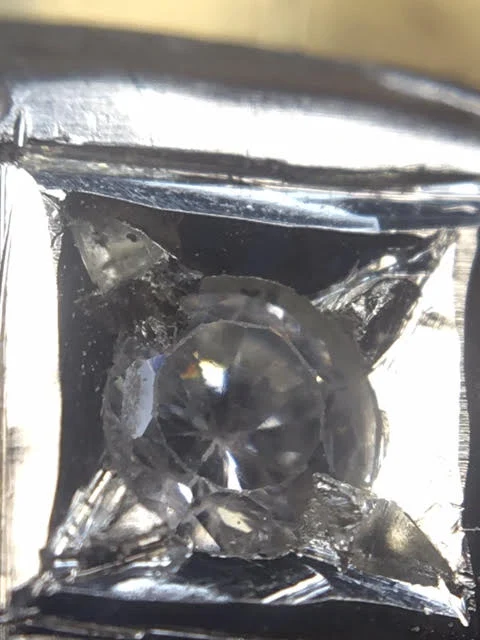While working as "Second-in-Command" as a Diamond Setter in a major jewellery company in Toronto, Canada. I was fortunate to learn all the intricate styles of "Bright-Cutting".
One of the most elaborate metal-cutting designs was making patterns on a flat plate.
In those earlier days, we never had CAD (Computer Aided Design) as it was totally unheard of during the 1970's. Every pattern had to be created with a high level of proficiency. As we are all human, there were some errors in the cutting, but that was our ongoing training.
===========================================
I scribed with a marking pen a pattern which would become the basic overall design.
From each corner, I envisioned where each bead would be. This is like having 'a map of instructions' on the metal.
At each corner, I will cut a triangle, but why a triangle? Lets just say that this triangle will be where each bead will be then 'saved, created and used'.
Along the scribed line I will start a 'Rough shape' of a square. This square is the beginning of the overall pattern in the metal.
This is square is now nearly ready to proceed onward in creating a second 'outer' square. This is now where this cutting stops and gets ready for further metal designing. Being a master at using an Onglette graver is essential in this pattern.
The "Level of Difficulty" is (in my own words) at 15, out of 10. This pattern is not for the beginner in sculpturing metal.
A second square is marked in ink as a 'second guide' for the second 'outer pattern'. Please keep the inner square exactly as a "square shape", any touch-ups could be well advised. Keep your Onglette graver always in pristine condition, as no graver-slipping should occur.
There MUST be a separation of metal in between the two squares, the reason will be shown in the next photo.
Keep the inner corners clean and well cut. Spend extra time in this metal cleaning & sculpturing.
If you need to use a Flat graver for this inner cutting do so now with a #40 Flat graver. Don't always depend upon your Onglette graver, I use both graver shapes when needed.
That 'space' in between the two squares, that I was mentioning previously will be easily explained with this one photograph. Once that the inside of the inner square has been sufficiently cleaned and it meets your approval. =>LEAVE IT ALONE!
I have 3 sides "Bright-Cut" as the reasons are many. This is the literally the "before & after" cutting. Are you finally getting the idea of cutting two squares at once?
With your Onglette graver #2, just go over the 'corner-cutting' and touch-up the minor slipping. Don't worry, these 'slipping' do happen (occasionally).
Now is the time to create a bead to secure this large stone, but how?
I will round the bottom point of a wide Onglette #2 or #3. This is how the steel graver will dig in at the point of triangle 'we' prepared and carefully created a while back.
You should just 'dig in and push' the metal triangle over the Girdle of the stone'.
Examine that the new beads have metal well situated OVER THE GIRDLE. This metal IS NOW YOUR 4 BEADS. All you need now is to 'burnish these beads' with some strength in your hand. You are pushing loads of metal.
Here is a ultra-close-up of the process of 'creating beads'. Examine that every Bead is over the stone. You can view and understand the "how & why' the 4 triangles were so important in the beginning of this design.
This is the epitome in using the Onglette and Flat gravers in this project.
BTW, this simple cutting process took me literally months, if not years to perfect. With grinding wheel-shaping, polishing the gravers. Learning all of the aspects and subtle nuances in this Square Pattern.

























No comments:
Post a Comment